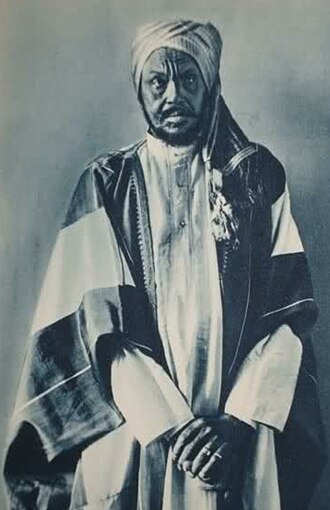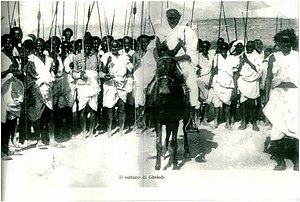Discover Your Roots
SIGN UPDiscover Your Roots
SIGN UPOsman is a male name of Arabic origin, meaning "Tender As A Youth." It is a Persian and Turkish transliteration derived from the Arabic masculine given name Uthman. The name Osman has historical significance, being associated with notable figures such as Osman I, the founder of the Ottoman Empire, and Osman II, an Ottoman sultan. Additionally, it has been used to name places, such as Osmanabad in India and Osman, Iran. In the realm of biology, the name Osman is linked to various fish species. Furthermore, it has been associated with a lunar crater, a video game, and a fictional character in the role-playing game Skies of Arcadia. The name Osman carries a rich and diverse legacy across different cultures and fields.

Osman Mahamuud, also known as Uthman III ibn Mahmud, was a Somali king who led the Majeerteen Sultanate during the 19th century. The Majeerteen Sultanate, established by Somalis from the Majeerteen Darod clan, rose to prominence under Boqor Osman's guidance. Notably, his kingdom entered into agreements with Britain and Italy, with the latter making his realm an Italian protectorate. Both rulers had signed the protectorate treaties to advance their own expansionist objectives and assure the continued independence of their territories. The terms of each treaty specified that Italy was to steer clear of any interference in the sultanates' respective administrations. In return for Italian arms and an annual subsidy, the Sultans conceded to a minimum of oversight and economic concessions. Osman's strategic maneuvering and leadership during this period played a significant role in the political landscape of the region. His legacy is an integral part of Somali history and the interactions between local rulers and colonial powers.

Osman Ahmed, also known as عثمان أحمد, was the fifth and final Sultan of the Geledi Sultanate in Somalia, reigning in the late 19th and early 20th centuries. His rule was marked by a decline in the Sultanate's power, with former allies and subjects claiming independence and religious leaders expanding their influence. Despite these challenges, Osman Ahmed was credited with defending the Rahanweyn territory against invasions from the Ethiopian Empire and the Dervish State. He also played a role in negotiating peace with the Bimaal clan and engaging in battles with the Dervish Army. Osman signed treaties with the Italians, ultimately leading to the incorporation of the Geledi state under direct Italian administration by 1911. Despite the decline of the Sultanate, Osman remained a notable traditional figure in Afgooye until his death in the early 1920s. His reign and the events surrounding it reflect a complex period in Somali history, marked by shifting alliances, conflicts, and the impact of European colonialism.

Osman Taka, a Cham Albanian dancer and enigmatic figure from the 19th century, is best known for the Dance of Osman Taka named after him. Little is known about his early life, but he was a member of the Taka clan of Filiates, renowned for producing Albanian patriot Alush Taka. Osman Taka gained prominence during the mid-19th century and was likely involved in resistance against the Ottomans in the Chameria region, possibly as a kachak or klepht. Some sources link him to the Albanian National Awakening of the late 19th century. Following his arrest in Ioannina, he was sentenced to death by Sultan Abdul Hamid II. When asked for his final wish, he requested to dance. Legend has it that his dance was so captivating that the Ottoman Army's local Albanian gendarmes spared him. However, he was eventually recaptured and executed in Konispol. Osman Taka's legacy lives on through the enduring folklore surrounding his life and the Dance of Osman Taka.

Osman Saqizli, also known as Osman Pasha of Chios, was a prominent figure in history as the Dey and Pasha of Tripolis from 1649 to 1672. Born into a Greek Christian family on the island of Chios, he later converted to Islam. During his rule, Osman Saqizli occupied Cyrenaica and was known for his religious tolerance. However, his reign was marked by conflicts with European powers due to the damages caused by Tripoli's Pirates to European trade. Retaliatory actions included bombings by the British, Dutch, and French navies. His death in 1672 marked the beginning of a period of instability for his country. Osman Saqizli's legacy is a complex one, characterized by effective rule, religious tolerance, and conflict with European powers. His leadership had a lasting impact on the history of Tripolis.

Osman López, born on 30 July 1970, is a former Colombian footballer known for his prowess as a central defender. His notable tenure with Millonarios de Bogotá earned him the moniker "El Fosforito". López's impactful presence on the field left a lasting impression in the world of football. Throughout his career, he showcased exceptional skills and dedication, garnering admiration from fans and fellow players alike. His contributions to the sport have solidified his status as a respected figure in Colombian football history. For more information, visit Osman López at National-Football-Teams.com.
All images displayed on this page are sourced from Wikipedia or Wikimedia Commons.We use these images under their respective Creative Commons or public domain licenses. Wherever applicable, author attributions and license information are provided. If you believe an image is used incorrectly or outside its license terms, please contact us so that we can review and correct the issue.